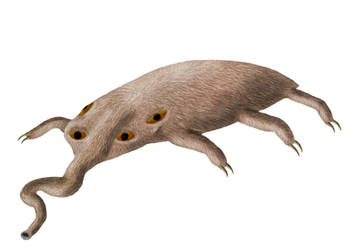Deviation Actions
Description
Wild Boar
Time: Holocene Epoch
The first common recognizable ancestor of these small beings, and really one of the most prominent mammals of the mankind era,
After the departure of the humans, these creatures with its excellent adaptability, they were able to take several of the niches both of mesofauna as megafauna.
Dwarf European Boar
Time: Lethargocene Epoch
This special descendant of the wild boar is characterized as a form of reduced suid, almost twice small relative to their ancestors, which live around the newly formed mountain ranges which was the Mediterranean Sea. Unlike its ancestor, this genus develops in drier environments and with less amounts of food, being able to better withstand periods of scarcity especially in mountainous areas and plains,
Minor mass extinction event, late Quaternary by an Asteroid impact around Siberia causes the death of the half of animal species.
Styleohyus
Time: Exevocene Epoch
After the extinction of the Late Quaternary event, the few survivors of the Suidae family have begun to colonize the world, and the genus Styleohyus is the pillar of a new generation of specialized groups of mammals.
Protounguceta
Time: Optimacene Epoch
One of the branches from of the genus Styleohyus, this clade of marine ungulate is specializing to colonize the oceans as the successor of the cetaceans, taking a path similar to them. Many of these forms are smaller and similar to the genus Indohyus.
Anomalopleusus
Time: Crescgeon Period
Some of the descendants of the Protounguceta varied in directions, so the result was a completely different evolutionary path. The Anomalopleusus is a coastal genus of a new growing clade of aquatic mammals; however, they are adapted to coastal life. They have a unique morphology; have a compact body with huge hind legs that help you swim while the front legs used to hang in the background when it feeds. The hooves became atrophied and instead of them, they developed functional fingers.
Dendrolutroides
Time: Crescgeon Period
The previous genus had spread across of the east coast of the newly formed continent Hyperborea, and some of their descendants were derived in more unusual ways depending on the circumstances of their environment. The Dendrolutroides are a kind of little insectivore-like aquatic mammals inhabiting mainly the estuaries and swamps conformed by mangrove-like trees around the new coast of East Africa. The most important aspect of this animal is that most of the time it stays outside of water, stays in the trees, mainly on the roots and branches of the mangroves and pass most of its life living up of those ones.
Mottling Yapker
Time: Late Crescgeon
The most derived form of this lineage, an arboreal being which has taken advantage of the circumstances of their environment to evolve to that point, it turns out to be one of the tiniest of its whole clade.

































